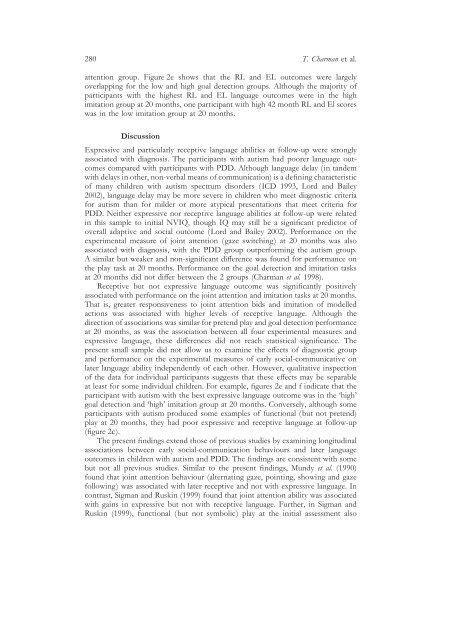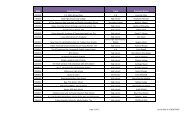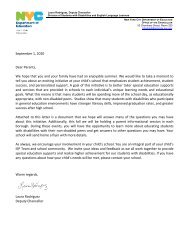Predicting language outcome in infants with autism and pervasive ...
Predicting language outcome in infants with autism and pervasive ...
Predicting language outcome in infants with autism and pervasive ...
You also want an ePaper? Increase the reach of your titles
YUMPU automatically turns print PDFs into web optimized ePapers that Google loves.
280T. Charman et al.attention group. Figure 2e shows that the RL <strong>and</strong> EL <strong>outcome</strong>s were largelyoverlapp<strong>in</strong>g for the low <strong>and</strong> high goal detection groups. Although the majority ofparticipants <strong>with</strong> the highest RL <strong>and</strong> EL <strong>language</strong> <strong>outcome</strong>s were <strong>in</strong> the highimitation group at 20 months, one participant <strong>with</strong> high 42 month RL <strong>and</strong> El scoreswas <strong>in</strong> the low imitation group at 20 months.DiscussionExpressive <strong>and</strong> particularly receptive <strong>language</strong> abilities at follow-up were stronglyassociated <strong>with</strong> diagnosis. The participants <strong>with</strong> <strong>autism</strong> had poorer <strong>language</strong> <strong>outcome</strong>scompared <strong>with</strong> participants <strong>with</strong> PDD. Although <strong>language</strong> delay (<strong>in</strong> t<strong>and</strong>em<strong>with</strong> delays <strong>in</strong> other, non-verbal means of communication) is a def<strong>in</strong><strong>in</strong>g characteristicof many children <strong>with</strong> <strong>autism</strong> spectrum disorders (ICD 1993, Lord <strong>and</strong> Bailey2002), <strong>language</strong> delay may be more severe <strong>in</strong> children who meet diagnostic criteriafor <strong>autism</strong> than for milder or more atypical presentations that meet criteria forPDD. Neither expressive nor receptive <strong>language</strong> abilities at follow-up were related<strong>in</strong> this sample to <strong>in</strong>itial NVIQ, though IQ may still be a significant predictor ofoverall adaptive <strong>and</strong> social <strong>outcome</strong> (Lord <strong>and</strong> Bailey 2002). Performance on theexperimental measure of jo<strong>in</strong>t attention (gaze switch<strong>in</strong>g) at 20 months was alsoassociated <strong>with</strong> diagnosis, <strong>with</strong> the PDD group outperform<strong>in</strong>g the <strong>autism</strong> group.A similar but weaker <strong>and</strong> non-significant difference was found for performance onthe play task at 20 months. Performance on the goal detection <strong>and</strong> imitation tasksat 20 months did not differ between the 2 groups (Charman et al. 1998).Receptive but not expressive <strong>language</strong> <strong>outcome</strong> was significantly positivelyassociated <strong>with</strong> performance on the jo<strong>in</strong>t attention <strong>and</strong> imitation tasks at 20 months.That is, greater responsiveness to jo<strong>in</strong>t attention bids <strong>and</strong> imitation of modelledactions was associated <strong>with</strong> higher levels of receptive <strong>language</strong>. Although thedirection of associations was similar for pretend play <strong>and</strong> goal detection performanceat 20 months, as was the association between all four experimental measures <strong>and</strong>expressive <strong>language</strong>, these differences did not reach statistical significance. Thepresent small sample did not allow us to exam<strong>in</strong>e the effects of diagnostic group<strong>and</strong> performance on the experimental measures of early social-communicative onlater <strong>language</strong> ability <strong>in</strong>dependently of each other. However, qualitative <strong>in</strong>spectionof the data for <strong>in</strong>dividual participants suggests that these effects may be separableat least for some <strong>in</strong>dividual children. For example, figures 2e <strong>and</strong> f <strong>in</strong>dicate that theparticipant <strong>with</strong> <strong>autism</strong> <strong>with</strong> the best expressive <strong>language</strong> <strong>outcome</strong> was <strong>in</strong> the ‘high’goal detection <strong>and</strong> ‘high’ imitation group at 20 months. Conversely, although someparticipants <strong>with</strong> <strong>autism</strong> produced some examples of functional (but not pretend)play at 20 months, they had poor expressive <strong>and</strong> receptive <strong>language</strong> at follow-up(figure 2c).The present f<strong>in</strong>d<strong>in</strong>gs extend those of previous studies by exam<strong>in</strong><strong>in</strong>g longitud<strong>in</strong>alassociations between early social-communication behaviours <strong>and</strong> later <strong>language</strong><strong>outcome</strong>s <strong>in</strong> children <strong>with</strong> <strong>autism</strong> <strong>and</strong> PDD. The f<strong>in</strong>d<strong>in</strong>gs are consistent <strong>with</strong> somebut not all previous studies. Similar to the present f<strong>in</strong>d<strong>in</strong>gs, Mundy et al. (1990)found that jo<strong>in</strong>t attention behaviour (alternat<strong>in</strong>g gaze, po<strong>in</strong>t<strong>in</strong>g, show<strong>in</strong>g <strong>and</strong> gazefollow<strong>in</strong>g) was associated <strong>with</strong> later receptive <strong>and</strong> not <strong>with</strong> expressive <strong>language</strong>. Incontrast, Sigman <strong>and</strong> Rusk<strong>in</strong> (1999) found that jo<strong>in</strong>t attention ability was associated<strong>with</strong> ga<strong>in</strong>s <strong>in</strong> expressive but not <strong>with</strong> receptive <strong>language</strong>. Further, <strong>in</strong> Sigman <strong>and</strong>Rusk<strong>in</strong> (1999), functional (but not symbolic) play at the <strong>in</strong>itial assessment also




